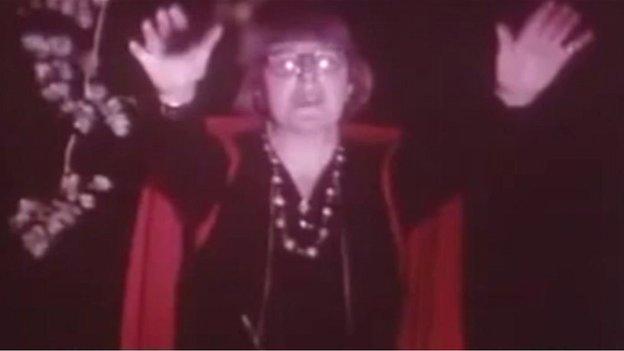Brighton witch Doreen Valiente gets blue plaque
- Published

Doreen Valiente was one of the first to speak openly about witchcraft when it ceased to be illegal in 1951
A witch living in a block of flats in Brighton was "very reclusive - she just was there - you knew she was there but you never saw her", says her neighbour.
Doreen Valiente, who was known as the "mother of modern witchcraft", lived in Tyson Place until her death in 1999 and is to be honoured with a blue plaque on the side of the block of flats where she lived.
Ralph Harvey who read the eulogy at her funeral, described her as "a very gentle lady".
"Witchcraft was always shrouded in mystery and medieval superstition," he said.
"Doreen and Gerald Gardner brought it into the 20th century, they blew away the cobwebs and this was the renaissance of witchcraft as it truly is."
Casting a spell
Valiente was born in 1922 to religious parents and was brought up as a Christian.
She began to experiment with simple magic as a teenager, including casting a spell on a woman who her mother said was harassing her at work.

Doreen Valiente is credited with bringing witchcraft into the 20th century.
She was sent to a convent school, but walked out at the age of 15.
In 1952 she was introduced to Gerald Gardner and one year later she was initiated by him into "the craft".
She later took issue with parts of Gardner's book, Book of Shadows, and re-wrote it with sections of her own verse. This became the basis of the rituals of "Wicca" - modern witchcraft.
Modern day witches focus on healing and helping people, by channelling their thoughts and energy.
Witches, who can be male or female, can practise alone, while others are members of covens.
The major festivals of Wicca are known as sabbats. These are held eight times throughout the year and mark changes in the seasons.
During the 15th century, witches were seen as working with the devil and witchcraft remained illegal until 1951.
"People began to realise that witchcraft was not demonic, they did not do terrible rituals," Mr Harvey said.
He described modern witchcraft as a love of nature, animals and the beauty of the trees.
"Pagans were the original green party," the 85-year-old witch said.
'Phenomenally influential'
Mr Harvey described Valiente as "a great one" for women's rights.
In an interview recorded in 1988, Valiente said, external: "We are seeing a much greater development of feminist witchcraft, with women taking a much more leading role, and I think this is a good thing.
"This is going back to the original witchcraft. Now women are coming into their own."
Ashley Mortimer, a trustee of the Doreen Valiente Foundation said Valiente was "phenomenally influential".
When witchcraft ceased to be illegal in 1951, she was one of the first people to speak opening about practicing witchcraft, he said.
"It was her and Gerald Gardner speaking openly about the craft which ignited the spark which became the modern pagan revival.
"Doreen and Gerald took witchcraft from being an underground cult to the world's faster growing religion in a matter of decades."
'Leading witch'
Ann Ewings a resident at Tyson's Place. described Valiente as "very quiet and in the background".
"We used to refer to her as a white witch, which is a good witch," she said.
The blue plaque is due to be unveiled on 21 June, the summer solstice.
John Carmichael, from Visit Brighton, said: "To have a plaque for a witch is something that will be great for visitors because it gives them an insight into the people who live here and make the city what it is.
"I think the blue plaque will be interesting to people who live in the city who perhaps may not know of Doreen and the work that she did in the city."
He said pagans from all around the world were expected to be at the unveiling.
Mr Harvey said: "I think it's marvellous that at long last a blue plaque has been erected to a witch, a leading witch and a wonderful lady.
"It's a great great tribute to her."
- Published10 June 2013
- Published20 August 2012
- Published15 June 2012